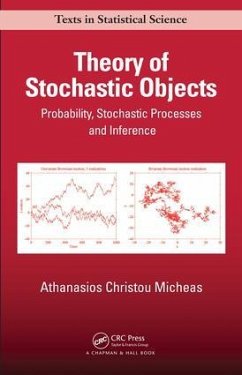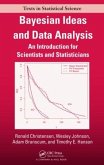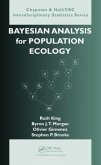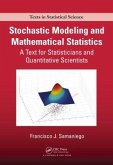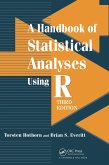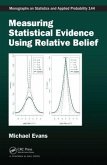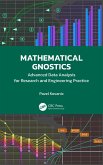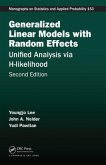This book defines and investigates the concept of a random object. To accomplish this task in a natural way, it brings together three major areas; statistical inference, measure-theoretic probability theory and stochastic processes. This point of view has not been explored by existing textbooks
Hinweis: Dieser Artikel kann nur an eine deutsche Lieferadresse ausgeliefert werden.
Hinweis: Dieser Artikel kann nur an eine deutsche Lieferadresse ausgeliefert werden.
"This impressive text presents a wealth of material in probability and statistics, backed with measure theory, topology, and functional analysis. The ambition is to integrate, from the very beginning, probability with statistical ideas, frequentists and Bayesian, to build an understanding of why, and how to construct stochastic models. The target readers are students (and teachers) at masters and PhD level, as well as researchers in probability and statistics. The style is very clear and precise but quite compact, and the author gives essential advice on how to select material for courses at different levels and with different contents, based on many years of experience. Every chapter contains many exercises, some asking for proofs of important theorems, completed with computing and simulation experiments."
-Georg Lindgren, Mathematical Statistics, Lund University
" This is an ambitious book, but perhaps those ambitions have been slightly frustrated. The author sets out with the objective of providing a unified treatment of the theory underlying random objects suitable for graduate students, but in the preface notes that this is beyond what is feasible in a single volume and defers some of the more advanced such objects to a forthcoming volume [A. C. Micheas, Theory and modeling of stochastic objects: point processes and random sets, CRC Press]. In that context it is, perhaps, unfair to consider this volume in isolation.
The title hints at possibly more exotic content than this particular volume provides. The definition of a random object given in this book (Definition 4.3) coincides with that usually used for random elements in classical probability texts such as [A. N. Shiryaev, Probability. 1, third edition, translated from the fourth (2007) Russian edition by R. P. Boas and D. M. Chibisov, Grad. Texts in Math., 95, Springer, New York, 2016; MR3467826], i.e., a suitably measurable map from a probability space to any general measurable space. The categories of such objects investigated in any detail in this book are random variables, random vectors, (discrete time) random sequences and (continuous time) random processes; there are eeting references to other settings, especially point processes and random sets, but, with the exception of Poisson processes which receive two pages in Chapter 7, these appear only as infrequent and rather involved examples which invariably direct the reader to the forthcoming companion volume for details.
Structurally, the book begins with two introductory chapters: the first frames proba-bility in an informal way and the second provides a condensed introduction to statistics. There is then a steady progress from a rigorous treatment of measure and integration in Chapter 3, through probability in Chapter 4 and stochastic notions of convergence in Chapter 5, to stochastic processes in discrete (Chapter 6) and continuous (Chapter 7) time. Of this material only Chapters 2 and 7 contain significant material which is absent from [A. N. Shiryaev, op. cit.], and a reader primarily interested in developing a detailed understanding of probability might find the more detailed treatment provided there or in a similar traditional probability textbook helpful.
The introduction to statistics, motivated by decision theoretic arguments in Chapter 2, is tasteful and about as complete as a single chapter introduction to a discipline could hope to be. However, a reader seriously interested in statistics would undoubtedly want to supplement their reading, and the book's focus is such that "applied" topics receive little attention (e.g., Remark 1.6 discusses prior specification from an essentially mathematical viewpoint, detailing six approaches, but expert elicitation does not get mentioned).
The main ideas are developed rigorously with proofs given or left as exercises, but there are more gaps than a text focussing solely on probability might contain-e.g., Carath´eodory's extension theorem is stated but not proved in Theorem 3.10. Those results that are viewed as less essential are often collected as lists of properties of types of object without explicit proof. This does lead to a digestible book and allows the reader to focus their energy on those technicalities which are treated as most essential. The treatment of those topics which are included is clear, readable and well supported with examples. The commitment to including realistic modern motivation and examples is well illustrated by the inclusion in Chapter 6, which introduces random sequences, of a development of the Reversible Jump Markov chain Monte Carlo algorithm [P. J. Green, Biometrika 82 (1995), no. 4, 711-732; MR1380810].
Numerous examples are presented to illustrate the abstract development; often se-quences of examples illustrate key concepts, with the first being very elementary and the last su ciently involved that it might not be easily digested on the first reading. Exam-ple 4.2 (random object examples) presents uniform random variables, random functions, random counting measures, random discs and then Gaussian random fields-with a ref-erence to the forthcoming companion volume-illustrating the great generality of the abstract concept while providing concrete enough examples to guide intuition. Solu-tions to the numerous exercises provided in the book and example code are available from the associated web page at https://www.crcpress.com/9781466515208-although, at the time of the writing this review, solutions are available only for the exercises from the first chapter.
This volume provides an approachable introduction to the theory of probability and stochastic processes; together with its companion volume it may well provide the more comprehensive guide which seems to be the aim."
- Adam M. Johansen - Mathematical Reviews Clippings - March 2019
-Georg Lindgren, Mathematical Statistics, Lund University
" This is an ambitious book, but perhaps those ambitions have been slightly frustrated. The author sets out with the objective of providing a unified treatment of the theory underlying random objects suitable for graduate students, but in the preface notes that this is beyond what is feasible in a single volume and defers some of the more advanced such objects to a forthcoming volume [A. C. Micheas, Theory and modeling of stochastic objects: point processes and random sets, CRC Press]. In that context it is, perhaps, unfair to consider this volume in isolation.
The title hints at possibly more exotic content than this particular volume provides. The definition of a random object given in this book (Definition 4.3) coincides with that usually used for random elements in classical probability texts such as [A. N. Shiryaev, Probability. 1, third edition, translated from the fourth (2007) Russian edition by R. P. Boas and D. M. Chibisov, Grad. Texts in Math., 95, Springer, New York, 2016; MR3467826], i.e., a suitably measurable map from a probability space to any general measurable space. The categories of such objects investigated in any detail in this book are random variables, random vectors, (discrete time) random sequences and (continuous time) random processes; there are eeting references to other settings, especially point processes and random sets, but, with the exception of Poisson processes which receive two pages in Chapter 7, these appear only as infrequent and rather involved examples which invariably direct the reader to the forthcoming companion volume for details.
Structurally, the book begins with two introductory chapters: the first frames proba-bility in an informal way and the second provides a condensed introduction to statistics. There is then a steady progress from a rigorous treatment of measure and integration in Chapter 3, through probability in Chapter 4 and stochastic notions of convergence in Chapter 5, to stochastic processes in discrete (Chapter 6) and continuous (Chapter 7) time. Of this material only Chapters 2 and 7 contain significant material which is absent from [A. N. Shiryaev, op. cit.], and a reader primarily interested in developing a detailed understanding of probability might find the more detailed treatment provided there or in a similar traditional probability textbook helpful.
The introduction to statistics, motivated by decision theoretic arguments in Chapter 2, is tasteful and about as complete as a single chapter introduction to a discipline could hope to be. However, a reader seriously interested in statistics would undoubtedly want to supplement their reading, and the book's focus is such that "applied" topics receive little attention (e.g., Remark 1.6 discusses prior specification from an essentially mathematical viewpoint, detailing six approaches, but expert elicitation does not get mentioned).
The main ideas are developed rigorously with proofs given or left as exercises, but there are more gaps than a text focussing solely on probability might contain-e.g., Carath´eodory's extension theorem is stated but not proved in Theorem 3.10. Those results that are viewed as less essential are often collected as lists of properties of types of object without explicit proof. This does lead to a digestible book and allows the reader to focus their energy on those technicalities which are treated as most essential. The treatment of those topics which are included is clear, readable and well supported with examples. The commitment to including realistic modern motivation and examples is well illustrated by the inclusion in Chapter 6, which introduces random sequences, of a development of the Reversible Jump Markov chain Monte Carlo algorithm [P. J. Green, Biometrika 82 (1995), no. 4, 711-732; MR1380810].
Numerous examples are presented to illustrate the abstract development; often se-quences of examples illustrate key concepts, with the first being very elementary and the last su ciently involved that it might not be easily digested on the first reading. Exam-ple 4.2 (random object examples) presents uniform random variables, random functions, random counting measures, random discs and then Gaussian random fields-with a ref-erence to the forthcoming companion volume-illustrating the great generality of the abstract concept while providing concrete enough examples to guide intuition. Solu-tions to the numerous exercises provided in the book and example code are available from the associated web page at https://www.crcpress.com/9781466515208-although, at the time of the writing this review, solutions are available only for the exercises from the first chapter.
This volume provides an approachable introduction to the theory of probability and stochastic processes; together with its companion volume it may well provide the more comprehensive guide which seems to be the aim."
- Adam M. Johansen - Mathematical Reviews Clippings - March 2019

